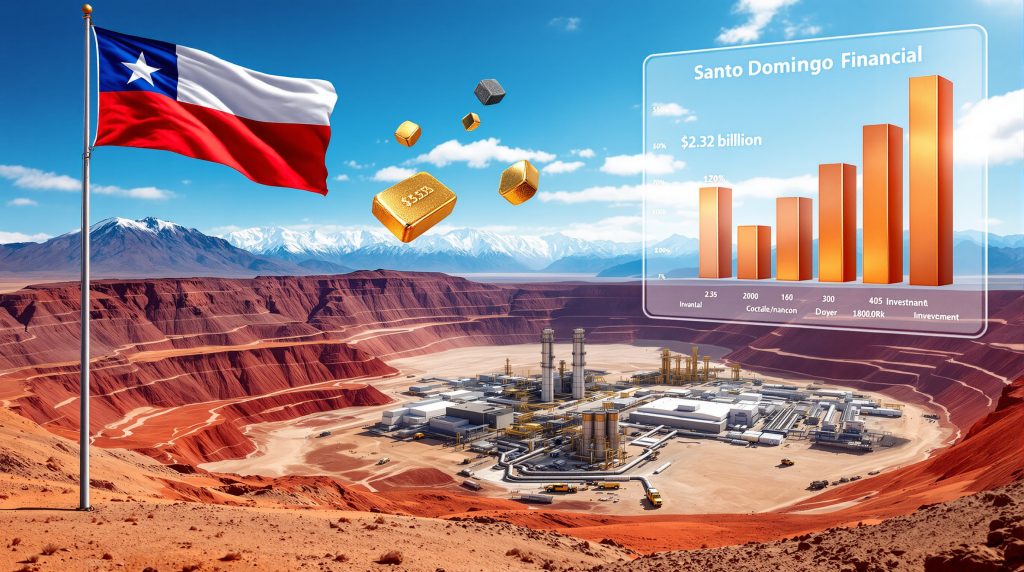Understanding Chile's Santo Domingo Mining District: A Comprehensive Project Analysis
The Santo Domingo copper/iron/gold project Chile represents one of the most significant multi-commodity development opportunities in South America's premier mining jurisdiction. Located in the mineral-rich Atacama Region, this expansive project encompasses both the primary Santo Domingo deposit and the adjacent Sierra Norte prospect, forming an integrated mining district with substantial expansion potential that reflects broader copper price insights shaping global mining investment decisions.
Project Location and Regional Context
The Santo Domingo mining district strategically positions itself within Chile's established mining corridor, providing critical advantages including existing transportation networks, skilled workforce availability, and proven regulatory frameworks that support large-scale mineral development. This location capitalises on the region's reputation for hosting world-class operations that have contributed billions to the national economy.
The district's geographic positioning offers direct access to Pacific Ocean shipping routes, enabling efficient export of copper concentrate and iron ore products to global markets. This coastal proximity becomes particularly valuable given the project's substantial iron ore component, which requires bulk shipping capabilities for economical transportation to international steel markets.
Furthermore, the Atacama Region's established infrastructure supports the Santo Domingo copper/iron/gold project Chile through existing power transmission networks, skilled labour pools, and supply chain relationships that reduce development risks and operational costs.
Multi-Commodity Resource Profile Overview
Santo Domingo distinguishes itself through its unique combination of copper, iron ore, and gold mineralisation within a single deposit. The project's total measured and indicated mineral resources span 547 million tonnes, containing copper grades of 0.31%, gold grades of 0.04 g/t, and iron content of 25.8% across 506 million tonnes of the resource base.
This multi-commodity profile creates significant operational synergies, allowing the project to generate revenue streams from multiple mineral products while sharing infrastructure costs. The substantial iron ore component provides a stable revenue foundation, as magnetite concentrate commands consistent demand from global steel producers seeking high-quality feed materials.
The mineral reserve estimate encompasses 436 million tonnes at grades of 0.33% copper, 26.5% iron ore, and 0.05 g/t gold, providing a robust foundation for the planned 19-year mine life. These reserves undergo continuous optimisation as exploration activities expand the resource base and metallurgical studies refine recovery parameters.
What Makes Santo Domingo a Strategic Copper-Iron-Gold Development?
Mineral Reserve Composition and Grade Analysis
The Santo Domingo copper/iron/gold project Chile demonstrates exceptional consistency across the deposit, supporting predictable mining operations and stable product quality. The copper grades of 0.33% position the project within commercially viable parameters for large-scale open-pit operations, while the 26.5% iron ore grades exceed typical magnetite concentrate specifications required by steel producers.
Metallurgical testing has confirmed strong recovery rates for all three commodities, with copper flotation circuits achieving optimal separation efficiency. The iron ore component exists primarily as magnetite, enabling straightforward magnetic separation processes that produce high-grade concentrate suitable for direct shipping to steel mills.
Additionally, gold recovery presents value creation opportunities, with the 0.05 g/t grade providing meaningful contribution to overall project economics. The gold mineralisation appears closely associated with copper sulphide zones, allowing for simultaneous recovery through existing flotation processes without requiring dedicated processing circuits.
Production Timeline and Output Projections
Santo Domingo's production profile emphasises front-loaded output during the initial seven years, averaging 106,000 tonnes of copper, 3.7 million tonnes of iron concentrate, and 35,000 ounces of gold annually. This production strategy maximises early cash flow generation, supporting rapid capital recovery and improved project returns.
Over the complete 19-year mine life, production levels moderate to sustainable averages of 68,000 tonnes of copper, 3.6 million tonnes of iron concentrate, and 22,000 ounces of gold per year. This production profile reflects the natural grade distribution within the deposit and optimised mine planning process that balances output consistency with operational efficiency.
The processing facility design supports maximum daily throughput of 72,000 tonnes, providing operational flexibility to accommodate grade variations and maintenance requirements. This capacity enables the project to maintain steady production levels while allowing for potential future expansion as additional resources are developed.
Integration Benefits with Existing Operations
Capstone Copper's ownership of the nearby Mantoverde operation creates substantial synergistic opportunities for Santo Domingo development. Shared infrastructure, technical expertise, and operational knowledge transfer significantly reduce development risks and enhance project execution capabilities.
The integrated district approach enables coordinated mine planning between Santo Domingo and Sierra Norte prospects, optimising resource extraction sequencing and processing plant utilisation. This strategic planning maximises equipment utilisation rates while minimising capital expenditure requirements for duplicate facilities.
Moreover, operational synergies extend to workforce management, supply chain optimisation, and maintenance facility sharing. These integrated efficiencies contribute meaningfully to reduced operating costs and improved overall project economics throughout the mine life.
How Will Santo Domingo Transform Chile's Mining Landscape?
Economic Impact Assessment for Atacama Region
The Santo Domingo copper/iron/gold project Chile represents a transformational economic catalyst for the Atacama Region, generating substantial direct and indirect economic benefits throughout the construction and operational phases. The project's $2.32 billion capital investment establishes one of Chile's largest recent mining developments, creating ripple effects across multiple economic sectors.
Regional suppliers and service providers benefit significantly from the project's procurement requirements, including specialised mining equipment, construction materials, and ongoing operational services. This local sourcing approach strengthens regional business networks while reducing transportation costs and delivery timelines for critical project inputs.
The project's substantial infrastructure development, including desalination facilities, port improvements, and transmission lines, creates lasting regional assets that benefit future economic development initiatives. These infrastructure investments often exceed individual project requirements, providing broader community and industrial benefits.
Employment Generation During Construction and Operations
Construction activities will generate approximately 6,000 jobs throughout the development phase, providing significant employment opportunities for skilled tradespeople, engineers, and support personnel across the Atacama Region. This substantial workforce requirement creates immediate economic benefits for local communities while developing regional expertise in large-scale mining construction.
Operational employment stabilises at more than 1,000 permanent positions once production commences, offering long-term career opportunities in mining, processing, maintenance, and administrative functions. These positions typically provide above-average wages and comprehensive benefits packages that support family economic stability.
Furthermore, the employment profile emphasises technical and skilled positions, creating training and development opportunities for regional workforce advancement. Collaboration with local educational institutions and training centres helps ensure adequate skilled labour availability while building regional mining expertise.
Tax Revenue Contributions Over Mine Life
Santo Domingo's fiscal contributions exceed $2 billion in total taxes over the 19-year mine life, providing substantial revenue for Chilean federal and regional government budgets. These tax payments support public infrastructure development, education systems, healthcare facilities, and social programmes benefiting local communities.
Tax revenue distribution includes corporate income taxes, mining-specific royalties, property taxes, and various operational levies that contribute to multiple government funding streams. The predictable nature of these payments enables long-term government planning and infrastructure investment programming.
Consequently, regional tax allocations specifically benefit Atacama Region municipalities and provincial governments, supporting local development initiatives and public service improvements. This targeted fiscal impact creates lasting community benefits that extend well beyond the project's operational timeline.
Santo Domingo's Technical Infrastructure and Processing Methods
Open-Pit Mining Operations Design
The Santo Domingo mining operation employs two separate open-pit mines utilising conventional drilling, blasting, and loading methodologies optimised for the deposit's geological characteristics. Electric and hydraulic shovels provide the primary loading capability, emphasising operational efficiency and reduced environmental impact through electrification initiatives.
Mine design parameters accommodate the deposit's scale and grade distribution, optimising strip ratios and ore recovery rates throughout the mine life. Advanced geotechnical analysis ensures slope stability and operational safety while maximising ore extraction efficiency.
Conventional drilling and blasting techniques enable precise fragmentation control, optimising downstream processing efficiency and reducing crusher wear. This integrated approach to mine-to-mill optimisation enhances overall operational productivity and equipment longevity.
Copper-Iron Concentrator Technology
The processing facility incorporates autogenous grinding technology for primary ore preparation, reducing energy consumption and maintenance requirements compared to conventional ball milling systems. This grinding approach proves particularly effective for Santo Domingo's ore characteristics, achieving optimal particle size distribution for downstream processing.
Copper recovery utilises conventional rougher cell flotation followed by regrinding and classification stages that optimise mineral liberation and concentrate grades. The flotation circuit design emphasises flexibility and efficiency, accommodating ore variability while maintaining consistent product quality.
Advanced Jameson Cell technology handles cleaner, cleaner scalper, cleaner scavenger, and recleaner flotation stages, providing superior separation efficiency and reduced reagent consumption. This technology selection reflects industry best practices for similar ore types and processing requirements.
Magnetite Recovery and Processing Systems
Magnetite iron recovery from copper rougher tailings employs low-intensity magnetic separation technology that efficiently extracts iron minerals while minimising processing complexity. This recovery approach maximises overall plant efficiency by utilising existing tailings streams as feed material for iron concentrate production.
The magnetic separation circuit produces high-grade magnetite concentrate suitable for direct shipping to steel mill customers without requiring additional beneficiation. This product quality meets international specifications for steel production feed materials, ensuring strong market acceptance and premium pricing.
Iron concentrate handling systems include pipeline transportation to port facilities, filtration and stockpiling equipment, and ship-loading capabilities designed for efficient bulk material handling. These systems minimise product degradation and handling costs while ensuring reliable delivery to international customers.
What Are the Key Financial Metrics for Santo Domingo?
Capital Investment Requirements Breakdown
| Investment Category | Amount (USD) | Percentage of Total |
|---|---|---|
| Processing Plant | $1.2 billion | 52% |
| Infrastructure | $680 million | 29% |
| Mining Equipment | $320 million | 14% |
| Contingency | $120 million | 5% |
| Total | $2.32 billion | 100% |
The $2.32 billion total capital expenditure requirement positions Santo Domingo among Chile's largest recent mining developments, reflecting the project's scale and comprehensive infrastructure requirements. Processing plant investments represent the largest component, encompassing grinding, flotation, magnetic separation, and concentrate handling facilities.
Infrastructure investments include desalination plant construction, concentrate pipelines, port facility development, transmission line installation, and tailings storage facility construction. These infrastructure components provide essential project support while creating lasting regional assets.
Mining equipment capital encompasses mobile fleet acquisition, including haul trucks, loaders, drills, and auxiliary equipment required for efficient open-pit operations. The equipment selection emphasises operational efficiency, maintenance accessibility, and environmental performance standards.
Revenue Projections and Return Analysis
Santo Domingo demonstrates robust financial returns with an after-tax net present value of $1.7 billion at an 8% discount rate, indicating strong project viability across various economic scenarios. The 24.1% internal rate of return significantly exceeds typical mining project thresholds, reflecting favourable commodity price assumptions and operational efficiency expectations.
The three-year payback period enables rapid capital recovery, reducing project risk exposure and improving overall investment attractiveness. This accelerated payback reflects the front-loaded production profile and strong early-year cash flow generation capabilities.
Multi-commodity revenue streams provide natural hedging against individual commodity price volatility, enhancing overall project stability and predictable cash flow generation. The combination of copper, iron ore, and gold sales creates diversified revenue sources that reduce dependence on any single market, similar to trends observed in iron ore market trends globally.
Payback Period and Risk Assessment
The three-year capital payback period demonstrates Santo Domingo's ability to generate strong early returns, minimising exposure to long-term commodity price uncertainties and operational risks. This rapid capital recovery enhances project financing attractiveness and reduces investor risk concerns.
Technical risks remain manageable given the conventional mining and processing methods employed, established operational precedents in similar deposits, and proven technology selections. Capstone's operational experience at nearby Mantoverde provides additional risk mitigation through technical knowledge transfer and operational expertise.
Market risks benefit from diversified commodity exposure and established customer relationships across copper concentrate and iron ore markets. The multi-commodity approach reduces concentration risk while providing flexibility to optimise production emphasis based on prevailing market conditions.
How Does the Orion Partnership Reshape Project Financing?
Strategic Investment Structure Analysis
Orion Resource Partners' strategic investment represents a sophisticated financing structure designed to optimise project development while maintaining operational control for Capstone Copper. The 25% ownership interest in the subsidiary holding both Santo Domingo and Sierra Norte provides Orion meaningful participation in district-wide value creation.
The $360 million total consideration structure spans multiple stages, beginning with $225 million at final investment decision, followed by $75 million within six months of FID, and concluding with $60 million in milestone-based payments. This staged approach aligns investor commitments with project development progress and risk reduction.
Additional $10 million share subscription at a 5% premium to market prices demonstrates Orion's confidence in Capstone's broader portfolio while providing exploration funding for district expansion opportunities. This investment structure creates shared incentives for successful project development and operational excellence.
Ownership Redistribution Impact
Post-transaction ownership adjustments result in Orion holding approximately 12% of Capstone Copper shares, subject to Toronto Stock Exchange approval, creating strategic alignment between project success and corporate performance. This ownership position provides Orion meaningful influence in corporate strategy while maintaining Capstone's operational control.
The partnership structure reduces Capstone's required equity contribution to approximately $400 million, significantly improving project financing feasibility and reducing balance sheet strain. This equity reduction enables more favourable debt financing terms and improved overall capital structure optimisation.
Shared ownership in the subsidiary structure creates aligned incentives for district-wide development, including potential Sierra Norte advancement and Santo Domingo expansion opportunities. This alignment encourages collaborative decision-making and optimal resource allocation across multiple development prospects.
Future Buyback Provisions and Implications
The buyback option enables Capstone to repurchase Orion's entire 25% subsidiary interest after Santo Domingo reaches commercial production, providing future strategic flexibility while ensuring Orion achieves specified investment returns. This provision protects both parties' interests while maintaining long-term strategic optionality.
Buyback pricing mechanisms designed to deliver specified Orion returns create predictable exit strategies that support investment decision-making and risk assessment. This structure provides certainty for Orion while preserving Capstone's ability to consolidate district ownership.
The milestone-based $60 million payment structure tied to Sierra Norte sulphide reserves, Santo Domingo oxide feasibility, and cobalt processing circuit development incentivises comprehensive district evaluation and value optimisation. These milestones encourage systematic exploration and development activities across the broader mineral district.
What Environmental and Infrastructure Considerations Define the Project?
Desalinated Water Supply Systems
Santo Domingo's water supply strategy centres on third-party-operated desalination facilities connected via dedicated pipeline infrastructure, ensuring reliable freshwater access without competing with regional municipal or agricultural water demands. This approach addresses Chile's increasing focus on sustainable water management in mining operations.
Desalinated water supply provides consistent quality and quantity regardless of seasonal variations or regional drought conditions, supporting steady production rates throughout the mine life. The external operation model reduces project complexity while leveraging specialised desalination expertise and operational efficiency.
Pipeline infrastructure connecting the desalination plant to mine facilities incorporates modern materials and monitoring systems that minimise water losses and ensure supply reliability. This infrastructure investment creates lasting regional assets that may support future development projects or community water supply initiatives.
Tailings Management and Storage Solutions
The tailings storage facility design incorporates modern engineering standards and environmental safeguards that exceed Chilean regulatory requirements and international best practices. Advanced geotechnical analysis ensures long-term structural stability while minimising environmental impact potential.
Tailings management protocols emphasise water recovery and recycling, reducing overall freshwater consumption while maximising processing circuit efficiency. This closed-loop approach minimises environmental discharge requirements and optimises water resource utilisation throughout the operation.
Progressive rehabilitation planning integrates with tailings deposition schedules, enabling early revegetation and ecosystem restoration activities during the operational phase. This proactive approach reduces post-closure environmental obligations while demonstrating environmental stewardship commitment.
Port Facilities and Transportation Networks
Port infrastructure development includes specialised magnetite concentrate filtration and stockpiling facilities designed for efficient bulk material handling and ship loading operations. These facilities accommodate the substantial iron ore production volumes while maintaining product quality during storage and transportation.
Copper concentrate storage facilities provide secure, weather-protected storage with advanced ventilation and material handling systems that preserve product quality and minimise environmental exposure. The storage capacity accommodates production variations and shipping schedule optimisation.
Transportation infrastructure connecting mine facilities to port installations includes the iron magnetite concentrate pipeline and high-voltage transmission line, creating integrated logistics networks that optimise operational efficiency and reduce transportation costs throughout the mine life.
Santo Domingo's Position in Global Copper Supply Chains
Production Capacity Comparison with Major Producers
Santo Domingo's initial seven-year average copper production of 106,000 tonnes annually positions the project among Chile's mid-tier copper producers, contributing meaningfully to national copper output while maintaining operational scale advantages. This production level places Santo Domingo within the top 20% of global copper operations by annual output.
The project's 68,000 tonnes annual average over the full mine life provides sustained contribution to global copper supply, equivalent to approximately 0.3% of current worldwide copper production. This scale ensures market relevance while maintaining manageable operational complexity and capital requirements.
Chile's position as the world's largest copper producer benefits from Santo Domingo's additional capacity, helping maintain national market leadership and supporting continued economic development. The project's high-quality concentrate specifications ensure ready market acceptance and premium pricing opportunities, contributing to broader gold-copper exploration trends across the region.
Market Timing and Commodity Price Sensitivity
Santo Domingo's development timeline targets production commencement during anticipated copper supply deficits driven by global electrification trends and renewable energy infrastructure development. This market timing positions the project to benefit from sustained copper demand growth across multiple industrial sectors.
The multi-commodity revenue structure provides natural hedging against copper price volatility, with iron ore and gold contributing stable alternative revenue streams. This diversification reduces project sensitivity to individual commodity cycles while maintaining exposure to favourable market trends reflected in current gold price analysis.
Operational flexibility enables production optimisation based on prevailing commodity prices, allowing management to emphasise higher-value products during favourable market conditions. This adaptability enhances overall project economics and risk management capabilities.
Supply Security Implications for International Markets
Chile's stable political environment and established mining regulatory framework provide international customers reliable supply security that supports long-term purchase agreement negotiations. This stability premium often translates to favourable pricing terms and customer loyalty benefits.
The project's substantial iron ore production addresses growing global demand for high-quality magnetite concentrate, particularly from Asian steel producers seeking premium feed materials. This market positioning creates additional revenue diversification and supply chain security benefits.
Santo Domingo's strategic location provides efficient access to Pacific Rim markets, including key customers in Asia and North America. This geographic advantage reduces transportation costs and delivery times while supporting competitive market positioning.
Frequently Asked Questions About Santo Domingo
When Will Commercial Production Begin?
Capstone Copper targets final investment decision approval during the second half of 2026, with commercial production expected approximately 3-4 years following FID approval. This timeline reflects comprehensive project financing completion, detailed engineering finalisation, and construction activity commencement.
The Orion partnership transaction closing remains expressly conditioned on FID approval and customary regulatory approvals, ensuring financing alignment with project development commitments. This conditional structure protects all parties while maintaining development momentum toward production targets.
Construction phase planning encompasses approximately 36-42 months from FID to first production, reflecting the project's scale and infrastructure complexity. Critical path activities include processing plant construction, infrastructure development, and mining equipment commissioning.
What Are the Main Technical Risks?
Primary technical risks include ore body geological variability, processing circuit performance optimisation, and infrastructure construction in remote locations. However, extensive feasibility study work, metallurgical testing, and geotechnical analysis have addressed most technical uncertainties through proven engineering solutions.
Processing technology risks remain minimal given the conventional copper flotation and magnetic separation methods employed, supported by extensive pilot plant testing and industry precedent. The technology selections emphasise proven performance rather than experimental approaches that could introduce operational uncertainties.
Infrastructure development risks primarily relate to construction execution in challenging desert environments, though Capstone's regional experience and contractor capabilities provide significant risk mitigation. Weather delays, equipment delivery logistics, and skilled labour availability represent manageable construction risks.
How Does This Compare to Other Chilean Copper Projects?
Santo Domingo's multi-commodity profile distinguishes it from traditional copper-only developments, providing revenue diversification advantages and enhanced project economics. The combination of copper, iron ore, and gold creates unique market positioning compared to single-commodity competitors.
Capital intensity of $2.32 billion aligns with other large-scale Chilean copper developments, though the multi-commodity revenue streams provide superior return profiles and payback periods. The project's financial metrics compare favourably to recent Chilean mining developments across multiple evaluation criteria.
The integrated district approach with Sierra Norte expansion potential creates long-term value opportunities that exceed typical single-deposit projects. This strategic positioning supports sustained operational life and additional development opportunities beyond the initial mine plan.
Investment Decision Timeline and Regulatory Pathway
Final Investment Decision Targeting Process
The second half 2026 FID target reflects comprehensive project development progress, including detailed engineering completion, construction contractor selection, and project financing finalisation. This timeline provides adequate preparation for efficient construction execution while maintaining market timing advantages.
FID prerequisites include regulatory permit finalisation, environmental approval completion, community agreement execution, and project financing documentation. These comprehensive requirements ensure all development aspects align before major capital commitment and construction commencement.
The Orion transaction structure directly links to FID approval, with $225 million initial investment triggered by positive investment decision. This alignment ensures financing availability coincides with construction funding requirements and project development momentum.
Permitting Status and Regulatory Approvals
Current permitting activities focus on environmental impact assessment completion and mining operation authorisation, building on preliminary regulatory engagement and community consultation processes. Chilean mining regulatory frameworks provide established pathways for large-scale project approval.
Environmental permitting encompasses comprehensive impact assessments, mitigation measure implementation, and long-term monitoring protocol establishment. These requirements ensure environmental protection compliance while supporting operational authorisation and social licence maintenance.
Community engagement processes emphasise local benefit sharing, employment opportunity creation, and infrastructure development contribution. These collaborative approaches support regulatory approval while building sustainable community relationships throughout the operational timeline.
Construction Phase Planning and Milestones
Construction sequencing prioritises critical path infrastructure development, including processing plant foundation work, major equipment installation, and utility system establishment. Early focus on long-lead-time components ensures schedule adherence and efficient resource allocation.
Key construction milestones include infrastructure completion, processing plant commissioning, mining equipment deployment, and operational readiness demonstration. These milestones provide progress measurement capabilities and contractor performance evaluation criteria.
Workforce planning encompasses peak construction employment of approximately 6,000 personnel, requiring comprehensive accommodation, transportation, and support service provision. This workforce management complexity demands detailed planning and regional resource coordination.
District Expansion Potential and Future Development
Sierra Norte Integration Opportunities
The Sierra Norte project represents significant expansion potential within the Santo Domingo district, sharing infrastructure and operational synergies that enhance overall development economics. Exploration funding from the Orion partnership specifically targets Sierra Norte resource definition and development planning.
Establishing sulphide reserves at Sierra Norte triggers additional Orion milestone payments, creating financial incentives for systematic exploration and resource expansion activities. This exploration focus may substantially extend district mine life and production capacity.
Integration opportunities include shared processing facilities, coordinated mine planning, and optimised infrastructure utilisation that maximise capital efficiency and operational productivity. These synergies create district-wide value that exceeds individual project contributions.
Cobalt Processing Circuit Development
Cobalt processing circuit advancement to feasibility and permitting stages represents innovative value creation within the Santo Domingo district, addressing growing battery metal demand through existing infrastructure utilisation. This development pathway could establish Chile as a significant cobalt producer.
The $60 million milestone payment structure incentivises cobalt circuit development alongside traditional copper-iron-gold processing, creating additional revenue streams and market diversification. This expansion demonstrates the district's adaptability to evolving commodity market demands.
Cobalt recovery integration with existing processing circuits minimises additional capital requirements while maximising resource utilisation efficiency. This approach provides cost-effective entry into battery metal markets without compromising primary commodity production.
Oxide Deposit Feasibility Assessment
Santo Domingo oxide deposit development represents potential mine life extension and production capacity expansion opportunities that build on existing infrastructure investments. Oxide ore processing typically requires different metallurgical approaches but can utilise shared mining and support facilities.
Completing feasibility studies for Santo Domingo oxides triggers additional Orion milestone payments while potentially adding substantial production capacity and reserve extensions. This development pathway provides long-term value creation beyond the initial sulphide operation.
Oxide processing integration may enable heap leaching or other cost-effective extraction methods that complement conventional flotation circuits. These technological approaches could extend district production life while maintaining operational efficiency and cost competitiveness.
Conclusion: Santo Domingo's Role in Chile's Mining Future
Strategic Importance for National Economy
The Santo Domingo copper/iron/gold project Chile represents a cornerstone development in Chile's continued mining sector evolution, contributing substantially to national copper production while introducing significant iron ore capacity. The project's $2.32 billion investment demonstrates continued international confidence in Chilean mining opportunities and regulatory stability.
The $2+ billion tax contribution over mine life provides substantial fiscal benefits that support national infrastructure development, education system enhancement, and social programme funding. These contributions extend project benefits well beyond direct operational impacts, creating lasting national economic value.
Regional economic transformation through 6,000 construction jobs and 1,000+ operational positions establishes Santo Domingo as a major Atacama Region economic driver. This employment generation creates multiplier effects across local service industries, retail sectors, and housing markets.
Technology Leadership in Multi-Commodity Processing
The integration of copper flotation, magnetic separation, and potential cobalt processing within a single facility demonstrates advanced metallurgical capabilities and operational efficiency optimisation. This technological approach establishes precedents for future multi-commodity developments across Chile and internationally.
Advanced processing technologies including autogenous grinding and Jameson Cell flotation represent industry best practices that maximise recovery efficiency while minimising environmental impact. These technology selections position Santo Domingo as a model for sustainable mining operations.
Environmental leadership through desalinated water supply, progressive tailings management, and infrastructure sharing demonstrates responsible mining practices that exceed regulatory requirements. This environmental stewardship approach supports social licence maintenance and long-term operational sustainability.
Long-Term Sustainability and Growth Prospects
District expansion potential through Sierra Norte development, oxide deposit evaluation, and cobalt processing advancement creates substantial long-term value beyond the initial 19-year mine plan. These expansion opportunities support sustained regional economic benefits and continued investment returns.
The Orion partnership structure provides access to additional capital and expertise that enhances development capabilities and risk management throughout the project lifecycle. This strategic relationship creates flexibility for future expansion and operational optimisation initiatives.
Santo Domingo's comprehensive approach to multi-commodity production, environmental stewardship, and community engagement establishes sustainable operating practices that support long-term success and stakeholder value creation. The project demonstrates how modern mining operations can generate substantial economic benefits while maintaining environmental and social responsibility standards.
Further Exploration:
Readers interested in learning more about major Chilean mining developments can explore additional educational content about copper project developments from Capstone Copper's official operations page and comprehensive project analysis from NS Energy Business for detailed technical and commercial insights.
Interested in the Next Major Chilean Mining Discovery?
Discovery Alert delivers instant notifications on significant ASX mineral discoveries using its proprietary Discovery IQ model, transforming complex mineral data into actionable investment opportunities. Explore how major mineral discoveries have generated substantial returns throughout history and begin your 30-day free trial today to position yourself ahead of the market.




